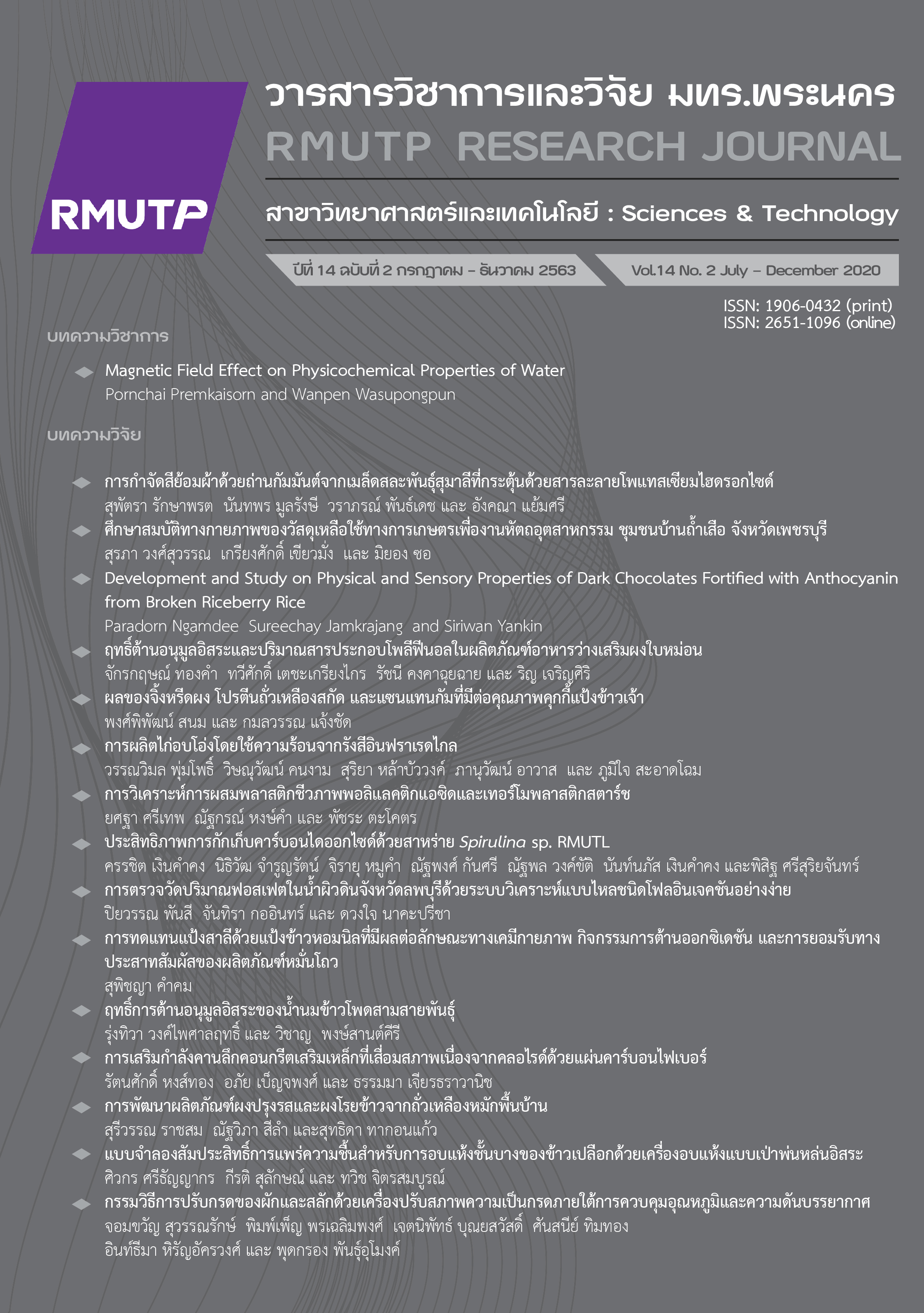CO2 Sequestration Efficiency by Spirulina sp. RMUTL
Main Article Content
Abstract
Increasing concentrations of CO2 in the atmosphere is causing severe environmental destruction to the earth. Bio-sequestration of CO2 is a promising way to completely sequester CO2 by converting it into biomass by way of photosynthesis. The current research focused on biomass productivity and CO2 sequestration efficiency using microalgae. The experiment choose Spirulina sp. RMUTL by cultivating in working volume 8 liters bioreactor with zarrouk's medium for 24-hrs with light nature and aeration air. The CO2 (100%) was flushed into the medium with a flow rate were 0.01, 0.02 and 0.03 vvm respectively. The period of all experiments were 30 days. The results showed that the maximum specific growth rate, OD560, algae biomass productivity, efficiency of CO2 reduction, CO2 fixation rate and carbon loading rate were 0.35±0.01 d-1, 0.85±0.00, 600.00±10.00 mg.L-1, 96.83±0.76%, 1,128.00±18.80 mg.L-1.d-1 and 20.41±0.26 g. d-1 with 0.01 vvm CO2 flow rate. The average CO2 sequestration over 30 days were 3.15.±0.03, 3.11.±0.02 and 3.07.±0.07% in 0.01, 0.02 and 0.03 vvm CO2 flow rate respectively.
Article Details
References
Office of Natural Resources and Environmental Policy and Planning, Report of Climate Change, 1st ed. Thailand: Text & Journal Public Company Limited, 2016.
Thairath. (2020, December 14). Climate Change. [Online]. Availiable: www.thairath.co.th/news/foreign/1723933
J.-W., Ahn, K. Hwangbo, S. Y. Lee, H.-G. Choi, Y.-L. Park, J. R. Liu and W.-J. Jeong, “Shorth communication anew arctic Chlorella species for biodiesel production,” Bioresource Technology, vol. 125, pp. 340-343, Dec. 2012.
P. Chitsanuphong, “Feasibility study of carbon dioxide recycling uning a biological wastewater treatment system for industrial sources,” Journal of Enviromental management, vol. 11, pp. 106-133, Dec. 2015.
A. Toledo-Cervantes, M. Marcia, N. Eberto and R. Sergio, “Carbon dioxide fixation and lipid storage by Scenedesmus obtusiusculus,” Bioresource Technology, vol. 130, pp. 652-658, Dec. 2012.
H. Seyedmahdi, A. Abbas, A. saeed, H. Mohamad Sadegh and M. Fatemeh, “Growht response of Spirulina platensis PCC9108 to elevated CO2 levels and flue gas,” Biological Journal of Microorganism, vol. 2, no. 8, pp. 29-36, Nov. 2014.
K. Chien-Y, C. Sheng-Yi, H. Tzu-Ting, D. Le, H. Ling-Kang and L. Chih-Shern, “Abitity of a mutant strain of the microalgae Chlorella sp. to capture carbon dioxide for biogas upgrading,” Applied Energy, vol. 93, pp. 176-183, Jan. 2012.
H. Shih-Hsin, C. Chun-Yen, L. Duu-Jong and C. Jo-Shu, “Perspectives on microalgal CO2-emission mitigation systems-A review,” Biotechnology Advances, vol. 29, pp. 189-198, Nov. 2010.
K. Wriju, G. Anuradda and M. Suparna, “Estimation of carbon dioxide sequestration potential of microalgae grown in a batch photobioreactor,” Bioresource Technology, vol. 180, pp. 370-375, Jan. 2015.
Z. Xianhai, D. Michael K., Z. Shiduo, Z. Xia, W. Mengyang, C. Xiao Dong, N. I-Son, J. Keju and L. Yinghua, “Autotrophic cultivation of Spirulina platensis for CO2 fixation and phycocyanin production,” Chemical Engineering Journal, vol. 183, pp. 192-197, Dec. 2011.
M.A.C. de Oliveira, M.P.C. Monterio, P.G. Robb and S.G.F. Lewite, “Growth and Chemical composition of Spirulina maxima and Spirulina patensis biomass at different temperature,” Aquaculture International, vol. 7, pp. 261-275, Jul. 1999.
E. Suali and R. Sarbatly, “Conversion of microalgae to biofuel,” Renewable and Sustainable Energy Reviews, vol. 16, pp. 4316-4342, Aug. 2012.
B. Melanie, D. Ignacio, D. Antonio, S. Armando Gonzalez and M. Raul, “Microalgal-Biotechnology as a platform for an integral biogas upgrading and nutrient removal from anaerobic effluents,” Environmental Science & Technology, vol. 48, pp. 573-581, Dec. 2013.
C. Alison, Use of microalgeae in wastewater treatment to remove contaminants and purify biogas, 1st ed, Canady: University of Guelph, 2011.
F. M. Salih, “Microalgae tolerance to high concentrations of carbon dioxide: A review,” Environmental Protection, vol. 2, pp. 648-654, Jan. 2011.
M. Michele Greque de and C. Jorge Alberto Vieira, “Carbon dioxide fixation by Chlorella kessleri, C. vulgaris, Scenedesmus obliquus and Spirulina sp. cultivated in flasks and vertical tubular photobioreactors,” Biotechnol Lett, vol. 29, pp. 1349-1352, May. 2007.
A. Kumar, X. Yuan, A.K. Sahu, S.J. Ergas, H. Van Langenhove, and J. Dewulf, “A hollow fiber membrane photo-bioreactor for CO2 sequestration from combustion gas coupled with wastewater treatment: a process engineering approach,” Journal of Chemical Technology and Biotechnology, vol. 85, pp. 387–394, Mar. 2010.
E.B. Sydney, W. Sturm, J.C. de Carvalho, V. Thomaz-Soccol, C. Larroche, A. Pandey, and C.R. Soccol, “Potential carbon dioxide fixation by industrially important microalgae,” Bioresource Technology, vol. 101, pp. 5892–5896, Aug. 2010.


